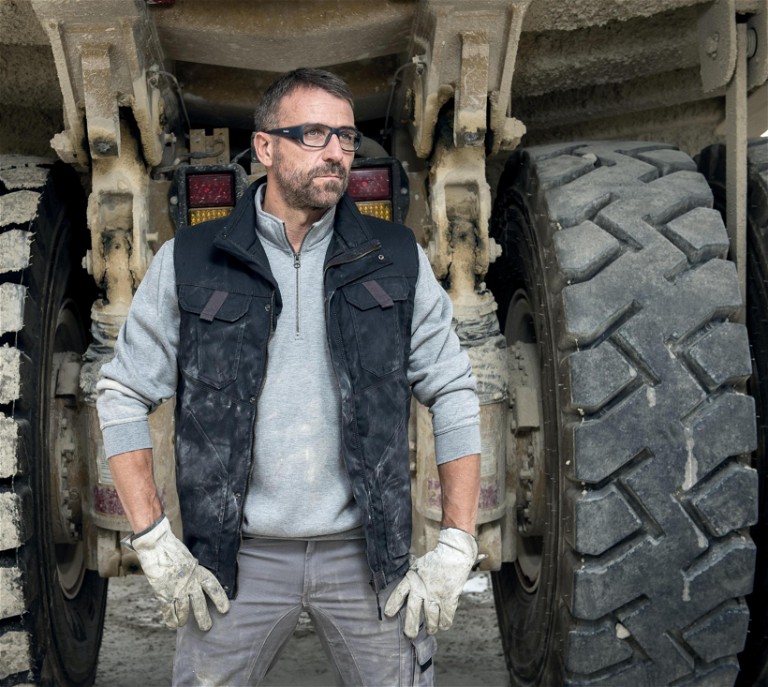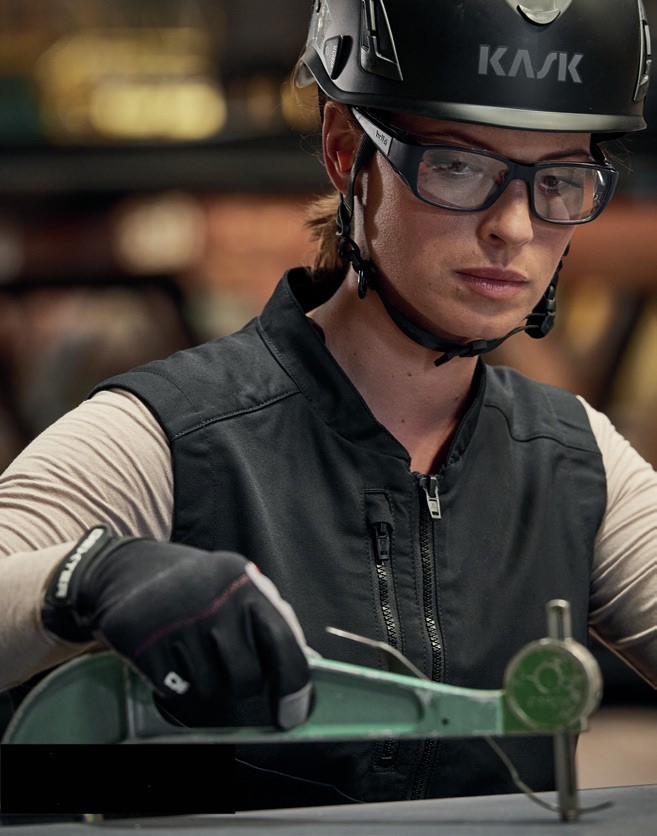mieyewear
Eyewear for Tradies

Protecting Vision on the Job
WRITER Olivia Dorn
Australia is renowned for its booming mining industry, its agriculture, and its constant cycles of construction. Our country relies on workers in these industries who face numerous hazards dayto-day, some of which can pose a risk to their ocular health. This means the importance of promoting eye protection to workers cannot be overstated.
As eye care professionals, our role extends beyond simply providing eyewear; we serve as advocates for occupational eye health, tailoring solutions to meet the unique needs of workers across diverse occupational settings.
Defending the eyes of workers is a concern, given the frequency of eye injuries in various industries. The main industries in which eye injuries appear to be problematic are manufacturing, agriculture, forestry, fishing, construction, and mining. Of these, the construction industry has the highest proportion of more severe eye injuries.1
Around 90% of eye injury cases result from inappropriate use of protective eyewear, or a lack of its use altogether.2 Those affected tend to be either young3 and relatively inexperienced, or workers who have not followed established safety procedures. This highlights the need to pay closer attention to frame fit when dispensing prescription safety spectacles and to changing the current culture surrounding personal protective equipment (PPE).4
In addition to workplace hazards, factors such as ergonomics and lighting are also known risk factors to eye health in the workplace that should be considered when advising patients.
A study conducted by Optometry Australia found that only 35% of employees in highrisk industries, such as construction and manufacturing, wear prescription safety glasses.5 However, two-thirds of Australians wear prescription glasses and recent trends indicate the need for prescription eyewear among workers is growing, whether for distance or near work.5
With the volume of eyewear sales expected to increase,6 we have an opportunity to bridge the gap between prescription eyewear and occupational safety standards.
ONSITE PROTECTION
Ensuring the safety of tradies’ vision begins onsite. Employers should be encouraged to consider conducting a cost analysis, weighing the price of providing employees with suitable eye protection against the cost of losing employees due to preventable injuries.7 Doing so will help shift the perception that eye protection is for everyone else to one of ‘eye protection is for me’.
One option to force cultural change would be to require pre-employment and periodic oculo-visual assessments to be conducted in all hazardous workplaces, as is already done when obtaining or renewing a driver’s licence. These assessments could include visual acuity examinations, binocular vision tests, evaluations of ocular health status, and identifying early signs of occupational eye disease or dysfunction.8 It is important to note that visual standards should not be set arbitrarily, but rather on the basis of a workplace survey and agreed visual requirements, with due regard to visual task analysis.9
One of the challenges faced by optical dispensers is to ensure that workers with prescriptions receive safety eyewear that specifically meets their visual needs while at work.
One day, while attending a dispensing job on a job site, I found myself assessing a worker who used progressive lenses as their everyday pair of glasses, but wore plano safety spectacles while working on a crane. Due to this person’s need for prescription lenses, we discussed progressive safety spectacles. However, by using various questioning techniques, I determined that progressive lenses would pose a difficulty for the person’s required focal lengths; the crane operator required full distance vision while looking down into the hatch, and intermediate vision above the pupil when using the screen in the crane. Without a full understanding of the crane operator’s role, an unsafe lens recommendation could have been made. An occupational bifocal ultimately ending up being more suitable.
WORKPLACE ASSESSMENTS
In Australia, mechanical and chemical eye injuries are among the most common types of work-related eye injuries. This highlights the need for comprehensive workplace hazard assessments9 and the importance of recommending protective eyewear with a proper fit and design.10
A hazard assessment sets out to identify the nature of hazards, such as chemical exposure, projectiles, and radiation; as well as determining the thresholds for worker exposure, safe handling procedures, and emergency measures. The information gathered can inform the selection of appropriate PPE, including tradie frames and lenses, to mitigate risks effectively.
As an eye care practitioner, it is possible to build your practice and drive revenue by providing businesses in your area with assessments for eye safety. Your assessments could also expand to offering advice on workplace ergonomics and lighting (in relation to eye health and vision protection).
DISPENSING SAFETY EYEWEAR
Safety spectacles are the most widely used occupational eye protectors, featuring full frames around the eye, side shields, and impact resistant lenses. Recommending eyewear that adheres to safety standards, such as AS/NZS 1337.1 and AS/NZS 1337.6, is crucial for ensuring effectiveness. Eyewear that is certified has been tested and audited by independent auditors like SAI Global to ensure the product’s continued compliance with safety standards. These safety frames cannot be reglazed, adjusted, or repaired. Safety eyewear that is described as ‘compliant’ means that it has completed manufacturer testing but has not been tested by a third party.
Even when workers wear approved and recommended eye protection, cases of eye injuries still occur, emphasising a gap between compliance with standards and actual protection.10
To ensure optimal protection and performance for your patients, it is important to assess various characteristics and standards of available safety lens materials, as well as how the eyewear will be used, before making a recommendation.
Both polycarbonate and Trivex lenses comply with AS/NZS 1337.6 standards for medium impact resistance, making them suitable choices for safety eyewear.11 However, there are notable differences between the two materials. Polycarbonate lenses have a higher impact resistance, withstanding higher velocities before breaking compared with Trivex. On the other hand, Trivex lenses offer less aberrations and clearer vision, due to a higher Abbe value. Additionally, Trivex is the lightest lens material commonly available, while polycarbonate lenses are approximately 10% thinner due to their higher refractive index. Trivex is twice as scratch resistant and demonstrates superior ability to withstand solvents and highly corrosive liquids compared to polycarbonate. Polycarbonate lenses are slightly cheaper, making them a cost-effective option for safety eyewear. Ultimately, the choice between polycarbonate and Trivex depends on specific requirements such as impact resistance, visual clarity, scratch resistance, and budget constraints.12
For tradies, also consider the abrasive environment of the worker. Those on the ground, working around a lot of projectiles, should not have laminates on their lenses because laminates reduce impact resistance. Although the reduction is insufficient to change the lens’ classification as a safety lens, it remains a factor for consideration. Laminated lenses are also less chemical resistant. Ideally, all safety spectacles used on the ground should be uncoated, and the wearer should have a separate, coated pair for walking around or office use.
DISPENSING MEASUREMENTS
Dispensing measurements, including monocular pupil distances and monocular heights for all safety eyewear, cannot be stressed enough. Inducing unwanted prism as a result of inaccurate binocular or missing measurements can alter the performance of the spectacles, potentially eliminating the ‘safety’ factor.

Bollé
It’s also important to remember that safety frames often sit closer to the eye than regular frames. This changes the vertex distance which can negatively affect the wearer’s prescription, unless compensated for. Optometrists can play a pivotal role in overcoming this problem by including the vertex distance on all prescriptions.
FRAME CHOICES
Most safety spectacles are made from polyamide/ nylon materials due to their chemical-resistant properties. These frame materials cannot be adjusted. While this is a benefit, as it stops customers from adjusting their frame and potentially losing the safety certification, it does mean that advice on frame selection is critical to ensure a secure fit. Without it, there will be problems down the track.13
Some safety frames are made from metal alloys, however these are not as common due to their conductive abilities. Often, the coverage of metal alloy is more limited than a thicker polyamide plastic, however, metal alloy can come less wrapped than polyamide.
Often, when safety spectacles need to be remade, it is due to dispensing a higher wrapped plastic frame. Therefore, there is a fine line between providing adequate protection and compromising visual outcomes.
BEYOND HAZARDOUS OCCUPATIONS
While impact resistance of lenses remains a primary focus of ‘safety spectacles’, it’s essential to also consider the broader context of vision protection in everyday life.
Australia’s harsh climate and outdoor lifestyle expose individuals to various environmental hazards, including UV radiation and bushfire smoke, which can pose significant risks to eye health. Protective measures include wearing goggles, which can act as a barrier against air pollutants that can cause severe eye conditions.14
While the damage of long exposure to sunlight is well known due to public health initiatives and sun awareness programs, 76% of Australians still don’t believe it is necessary to wear UV protective sunglasses in the winter months.5 This misconception contradicts the reality of UVB radiation being present throughout the year. Side effects of limited UV protection can include mild photokeratitis and damage to corneal epithelial cells.15 (As an aside, studies show most people accumulate over 50% of their lifetime exposure to solar UVB before reaching 20 years of age,16 indicating a great need to protect children from UV radiation with sunglasses). Workers who are regularly outdoors should be encouraged to mitigate the risks caused by sun exposure by including UV protection in clear spectacles17 as well as ensuring full protection up to 400 nm in everyday sunglasses.
“ defending the eyes of workers is a concern, given the frequency of eye injuries in various industries ”
It is important to note that contact lenses should not be regarded as a form of eye protection.18
SAFETY OUTSIDE OF WORK
Accidents can happen in or out of work,5 but the concern for eye health doesn’t change. I discussed this with Zoran Pajkovski, owner of optical wholesaler, Cerium Optical Australia. A keen basketball player in his spare time, Mr Pajkovski was pushed to the ground from a finger to the eye, resulting in a torn retina. Despite undergoing surgery, he developed band keratopathy and lost vision in his left eye.
Mr Pajkovski’s story serves as a reminder that, in an ideal world, safety spectacles should be worn more regularly. However, due to the refractive index and Abbe values of polycarbonate and Trivex lenses, this may never become a reality. At the end of the day, all we can do is provide recommendations so that individuals can make informed decisions on their visual appliances.19
Workers exposed to hazardous and outdoor environments face unique challenges related to eye protection. Understanding the specific job roles of trade workers, including their visual requirements, is essential for recommending appropriate eyewear solutions.
Issues, such as reduced visual acuity, inappropriate eyewear selection, and lack of awareness about safety standards, can contribute to eye injuries in these environments. Safeguarding tradies’ vision requires a comprehensive approach that encompasses onsite protection, oculo-visual assessments, hazard assessments, safety eyewear dispensing, and risk management beyond hazardous occupations.
Olivia Dorn is a qualified optical dispenser, a trainer and assessor at the Australasian College of Optical Dispensing (ACOD), and Optical Dispensing Instructor at the University of Western Australia (UWA). She is also a locum dispenser specialising in prescription safety glasses and provides volunteer dispensing services internationally.
References available at mivision.com.au